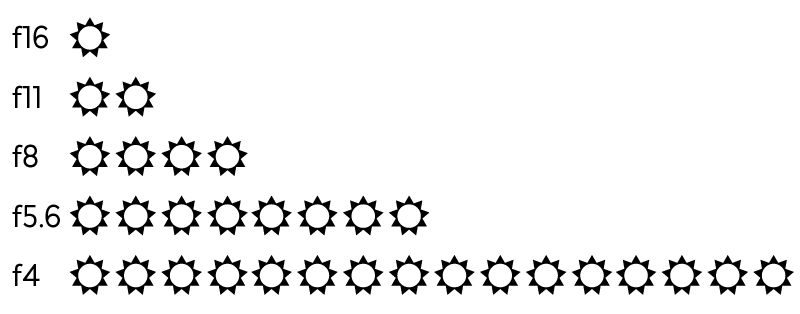The Exposure Triangle
Understanding Stops
What are stops?
Do you remember the list of aperture f-stops? And shutter speeds and ISOs? f4, f5.6, f8; 1/60th, 1/125th, 1/250th; 100, 200, 400?
The gap between these measures of aperture, shutter speed and ISO is important, and it's called a "stop".
From f4 to f5.6 is 1 stop. From 1/60th to 1/125th is 1 stop. From ISO 400 to ISO 800 is 1 stop. Each stop lets in the same amount of light. So 1 stop on the aperture scale corresponds to 1 stop on the shutter speed scale. Knowing this allows you to compensate accurately.
If the camera picked f5.6 but you want f11, that's 2 full stops smaller. f5.6 > f 8 > f11. So, to keep the same exposure, you would need to change the shutter speed by 2 full stops larger, eg. 1/500th < 1/250th < 1/125th. Or the ISO by 2 full stops larger; ISO 100 < ISO 200 < ISO 400. Or you could change the shutter speed by 1 full stop and the ISO by 1 full stop.
Full stops, half stops and third stops
The benchmark stops are the ones mentioned so far in the book. f4, f5.6, f8, f11, f16. 1/60th, 1/125th, 1/250th, 1/500th. ISO 100, 200, 400, 800. But you may find that your camera picks an aperture like f7.1, or a shutter speed of 1/160th. That's because there are stops that fall exactly half way between the benchmark full stops, and there are also stops that fall exactly a third and two thirds of the way between the benchmark full stops. Your camera will be set to show either full plus half, or full plus third stops. You can change between them.
It's not critical that you remember all the half stops and third stops, but you should be familiar with the benchmark full stops for each of the 3 settings:
Double the light / half the light
As you move between stops, remember that each stop lets in twice as much light as the one before it (rather than just +1 stop). This diagram shows the concept for apertures, so you can see the huge difference between each end of the scale:
Stops and the exposure triangle explained a bit more...
This is an excerpt from the video lesson that accompanies AYWMC. It explains stops and the exposure triangle in a more visual way, which some people find easier to understand than just reading about it (click the volume icon to hear the commentary):
Download chapter 5 from Book 1 here - it has all the information about stops, and the quiz to test yourself:
The test is intermediate level. Give it a go, but don't be discouraged if you find it hard. You'll be able to come back to it throughout the year and find it getting easier and easier.
The Workbooks are available on Amazon
Take a look at the workbooks if you haven't yet. The "Look Inside" feature is enabled on Amazon so you can flick through before you buy. There's also a short video on this page that gives you a guided tour:
“This is the first book I’ve found which really explains digital photography from first principles (& I have tried many). Originally I signed up for the weekly emails, thinking I’d save money and not buy the book, but the emails blew me away and I realised I needed it all in one place to easily refer to. This book is a must for anyone wanting to learn or improve their digital photography skills. My photos are so much better now and it’s made photography even more fun!”





